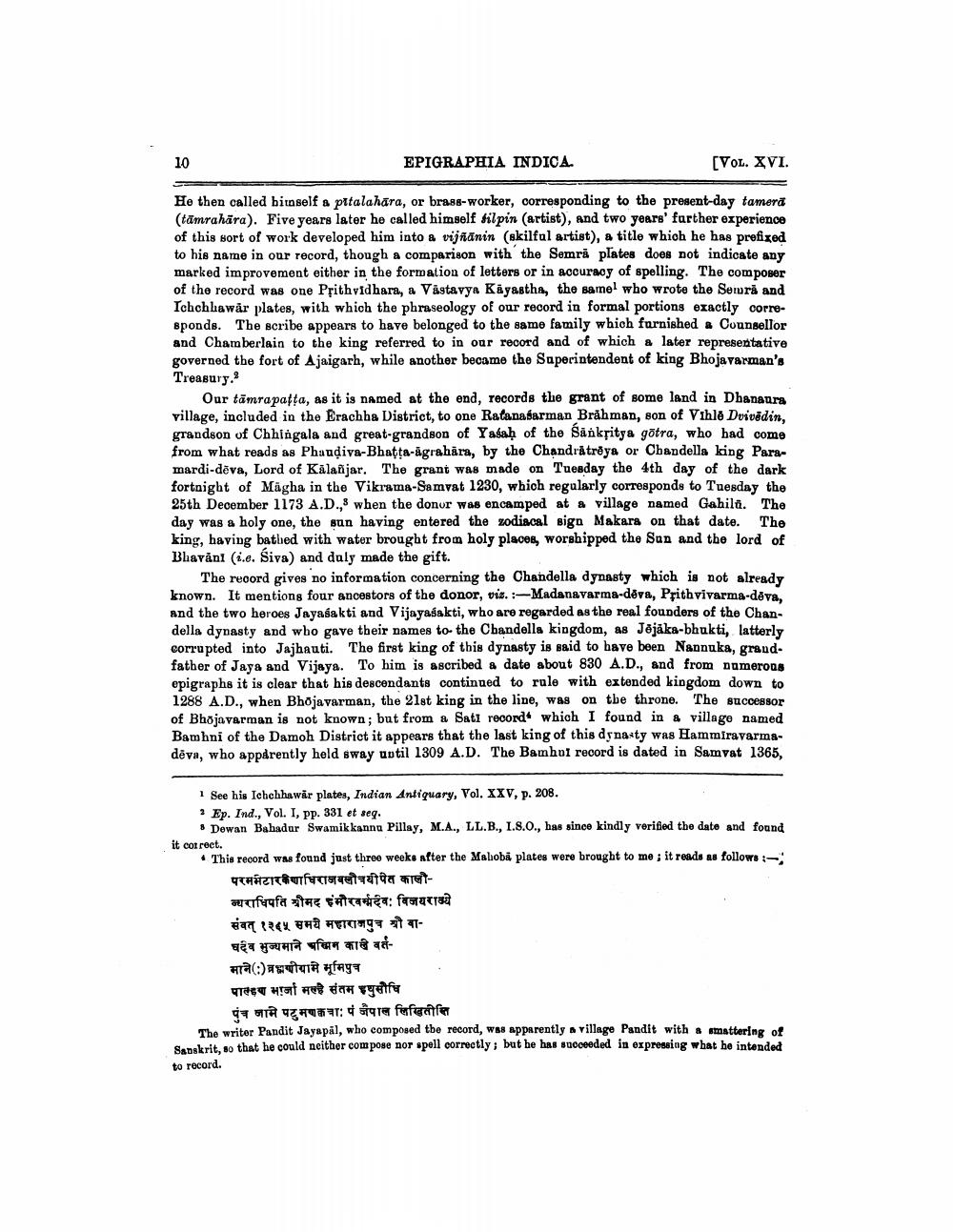________________
10
EPIGRAPHIA INDICA.
[VOL. XVI.
He then called himself a pitalahāra, or brass-worker, corresponding to the present-day tameră (tāmrahāra). Five years later he called himself filpin (artist), and two years' farther experience of this sort of work developed him into a vijñānin (skilful artist), a title which he has prefixed to his name in our record, though a comparison with the Semri plates does not indicate any marked improvement either in the formation of letters or in accuracy of spelling. The composer of the record was one Přithvidhara, a Vástavya Kiyastha, the samel who wrote the Semrå and Ichchhawar plates, with which the phraseology of our record in formal portions exactly corresponds. The scribe appears to have belonged to the same family which furnished a Counsellor and Chamberlain to the king referred to in our record and of which a later representative governed the fort of Ajaigarh, while another became the Superintendent of king Bhojavarman's Treasury.
Our tāmra pafta, as it is named at the end, records the grant of some land in Dhanaurs village, included in the Erachha District, to one Ratanaśarman Brahman, son of Vihlé Dvivēdin, grandson of Chhingala and great-grandson of Yaśaḥ of the Sanksitya gotra, who had come from what reads as Phaudiva-Bhatta-agrahara, by the Chandrätröya or Chandella king Paramardi-dēva, Lord of Kälajar. The grant was made on Tuesday the 4th day of the dark fortnight of Mägha in the Vikrama-Samvat 1230, which regularly corresponds to Tuesday the 25th December 1173 A.D., when the donor was encamped at a village named Gahila. The day was a holy one, the sun having entered the zodiacal siga Makara on that date. The king, having bathed with water brought from holy places, worshipped the Sun and the lord of Bhavani (1.6. Siva) and duly made the gift.
The record gives no information concerning the Chandella dynasty which is not already known. It mentions four ancestors of the donor, viz. :-Madanavarma-dēva, Prithvivarma-dava, and the two heroes Jayasakti and Vijayasakti, who are regarded as the real founders of the Chandella dynasty and who gave their names to the Chandella kingdom, as Jõjāka-bhukti, latterly corrupted into Jajhauti. The first king of this dynasty is said to have been Nannuka, grandfather of Jaya and Vijaya. To him is ascribed a date about 830 A.D., and from numerous epigraphs it is clear that his descendants continued to rule with extended kingdom down to 1288 A.D., when Bhojavarman, the 21st king in the line, was on the throne. The successor of Bhojavarman is not known; but from a Sati record which I found in & village named Bamhni of the Damoh District it appears that the last king of this dynasty was Hammiravarmadēva, who apparently held sway uptil 1309 A.D. The Bamhul record is dated in Samvat 1365,
See his Ichchhawår plates, Indian Antiquary, Vol. XXV, p. 208. ? Ep. Ind., Vol. I, pp. 331 et seq.
• Dowan Bahadur Swamik kanna Pillay, M.A., LL.B., 1.8.0., has since kindly verified the date and found it correct. • This record was found just three weeks after the Maloba plates were brought to me; it reads as follows:
परममेटारकैचाधिराजबलौचयीपत कालौन्धराधिपति श्रीमद ईमौरवर्मदेव: विजयराज्ये संवत् १२६५ समये महाराजपुत्र श्री वाचर्दव भुज्यमाने पस्मिन कारी वर्त#rac:)auitgawfATT पाल्या भार्जा मलहे संतम इथुसौधि
पुंच जामे पटुमणकचा: पं जैपाल लिखितीति The writor Pandit Jayapal, who composed the record, W38 apparently a village Pandit with a mattering of Sapskrit, so that he could neither compose nor spell correctly; but he has succeeded in oxpressing what be intended to record.




